#tibetan flute music
Text
#duet with @rj pasin #flute #dizi #jooleermusic #jooleer
2 notes
·
View notes
Text
#- melatonin meditation#- tibetan flute#- stress relief#- sleep music#- relaxation music#- meditation music#- healing music#- pineal gland activation#- hormone balance#- natural wellness
3 notes
·
View notes
Text
#- melatonin meditation#- tibetan flute#- stress relief#- sleep music#- relaxation music#- meditation music#- healing music#- pineal gland activation#- hormone balance#- natural wellness
2 notes
·
View notes
Text
https://youtu.be/_kZRHtsv6mc
#- melatonin meditation#- tibetan flute#- stress relief#- sleep music#- relaxation music#- meditation music#- healing music#- pineal gland activation#- hormone balance#- natural wellness
2 notes
·
View notes
Text
#- melatonin meditation#- tibetan flute#- stress relief#- sleep music#- relaxation music#- meditation music#- healing music#- pineal gland activation#- hormone balance#- natural wellness
0 notes
Text
#melatonin meditation#- tibetan flute#- stress relief#- sleep music#- relaxation music#- meditation music#- healing music#- pineal gland activation#- hormone balance#- natural wellness
1 note
·
View note
Text
I would like to sincerely apologize to everybody I have hurt and offended by forgetting to put my usual content warning tag on my latest Taylor Swift related reblog, you see I was too relaxed on account of listening to 8 hours tibetan flute healing music deep relaxation
9 notes
·
View notes
Video
youtube
Indian Flute and Tibetan Bowls, Deep Meditation, Remove all Negative Energy, Yoga Music, Healing
40 notes
·
View notes
Note
Since you mentioned music that the victors would like, i was wondering what genres would they listen to? I think you wrote somewhere that a band claudius liked disappeared because they criticised the games and that brutus likes country music
music in Panem is funny to think about bc I can only assume 'approved' music in a panopticon-surveillance hypercapitalist dystopia would be AWFUL (cough) and if you actually make the subversive kind you do, you know, actually get real-time murdered
Katniss sings a song and it becomes a rebel anthem and they're FURIOUS which tells me that 1) this doesn't happen often, OR 2) when it does they've been able to suppress it up to now
I feel like there's a very large soulless pop industry coming out of the Capitol that's meant to drive the latest trend and then the districts have their own various folk styles that may or may not cross over. punk, rock, grunge etc, anything that's actually overt, those are going to get shut down hard. folk songs can get away with it more because you think it's a work song about cows but it's actually revolution
sorry what was the question
Brutus was raised on bluegrass so it's a nostalgic thing for him but it's also very buried, it's not a thing he'd seek out until postwar when he's able to unpack all that, I think Devon would be the same and Emory is a big folk girl
I have a mini story about Electra introducing Claudius to jazz and blowing his mind (with a jab at Lyme because "of course" jazz is not her thing).
I think Odin would like opera, if those were still a thing? or, more like if the Capitol were capable of any kind of sincerity at this point
the ONLY thing I know about Lyme's music taste is 1) she hates jazz and 2) she hates Radiohead. they don't exist in Panem obviously but one time Paranoid Android came on by accident while I was writing a scene and the absolute visceral DISGUST I got in response was incredible. what does she like? idk. Claudius playing cello is fine
Petra doesn't really understand music tbh and does not like other people singing I think? but when I poke at her the general response I get is "percussion". lots of percussion, cool things with percussion. she would HATE a Blue Man Group concert because they upset her visually and people would cheer through the whole thing but she would listen to a recording and enjoy the sounds
Nero would like, you know how there's that genre of music on youtube that's like Chinese flutes played over the sound of running water, he'd have a playlist of 1000 hours of that
I feel like someone should listen to Wikipedia
I'm not sure if she'd actually LISTEN to this but Claudius definitely shows PlantWave Music to Eibhlin (and I'm sure they spend a fun time figuring out how to do it with the garden)
Misha I have no clue tbh. she'd claim to listen to all kinds of weird electroswing or terrible Capitol hyperpop bands ironically or whatever but I bet when she actually needs her brain to calm down for real she just listens to like ........... Tibetan bowls for 5 hours
20 notes
·
View notes
Text
4 notes
·
View notes
Note
Share those songs kimmie
I would but I don't have 500 years of spare time to share them. I will say that my list of music includes, but isn't limited to, reggaeton, random video game soundtracks (I don't even play video games,) Tibetan Buddhist chants, Mongolian throat singing, Native American flute music, Bob Marley, The Gorillaz, Mindless Self Indulgence, instrumental Indian sitar music, the soundtrack to Game of Thrones, dubstep, Lil Wayne, and drum and bass.
2 notes
·
View notes
Text
199: Zero Kama // Zero Kama
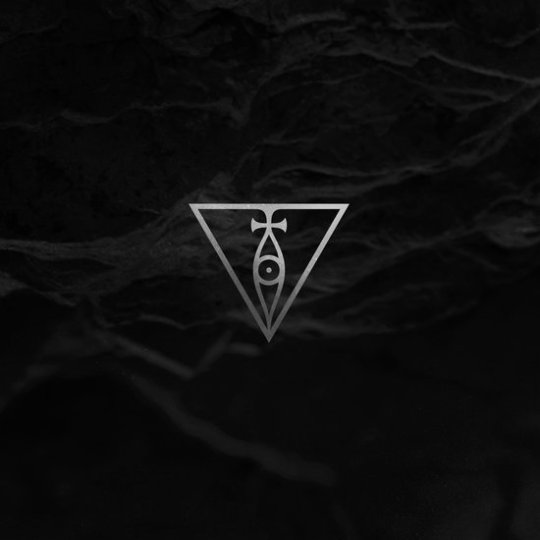
Zero Kama
Zero Kama
2020, Infinite Fog (Bandcamp)
“I followed the hint of a friend who had told me about a charnel house in the countryside, which could easily be entered in order to find the desired raw materials for my instruments. So I went there and took what I needed: about nine skulls and a huge number of different kinds of bones, from small fingers and toe bones up to arm and thighbones, which I thought could serve the various purposes I had in mind….
My already strange feeling became even stronger when I arrived in my apartment and unpacked my bags, so that finally the remains of let’s say some dozens of human beings were lying around. Some of the skulls still had hair on top, which resembled moss, and there was quite a ghostly atmosphere in the room, which gave me the strong impression that these bones were not simply raw material without any life in them, but that there were still remnants of consciousness connected to these bones, which I had set free by my disrespectful intervention. Another almost unbearable feature was the disgusting smell when sawing the bones… None of which I had expected, but I found myself at a point of no return, so that I could only finish what I had started. In fact, I realized that I really had transgressed fundamental borders both in a general human and personal psychic regard, and that there was no way back at all.” — Zoe DeWitt (Zero Kama)
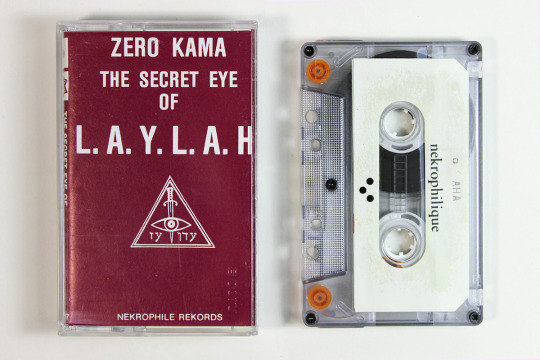
Originally released on cassette in 1984, Zero Kama’s The Secret Eye of L.A.Y.L.A.H. (Nekrophile Records) is one of the most notorious records to emerge from the first waves of industrial and dark ambient music (e.g. Throbbing Gristle, Coil, Nurse With Wound), less for its sonic profile than for the fact that it was recorded using instruments fashioned from stolen human bones. Zoe DeWitt, the Austrian artist and graverobber behind the project, was a devotee of Genesis P-Orridge’s Thee Temple ov Psychick Youth, an occult collective dedicated to chaos magic and experimental art. DeWitt conceived of L.A.Y.L.A.H. as a magical working, with its distinctive Eye insignia, song titles, and even date of recording designed according to obscure numerological principles, though I’m not sure she has ever disclosed the intention of the spell beyond a will to spooky power and a Crowleyan passion for inversion.
youtube
There is some precedent for instruments fashioned from human bone—for centuries, the Tibetan kangling (translated as “leg flute” or sometimes “thigh trumpet”) has been used in chöd practice to summon hungry spirits, and DeWitt was familiar with it thanks to its use on Psychic TV’s Dreams Less Sweet. DeWitt’s instruments are unique however, including a variety of rudimentary flutes and wind instruments using the longer bones; drums created by stretching sheepskin over sawn-open skullcaps; a thighbone xylophone; and a pair of rattles made from inserting loose fingerbones into two skulls. DeWitt claims L.A.Y.L.A.H. was made exclusively with these instruments, though she also used tape effects to stretch and distort the wind instruments and to create percussion loops.
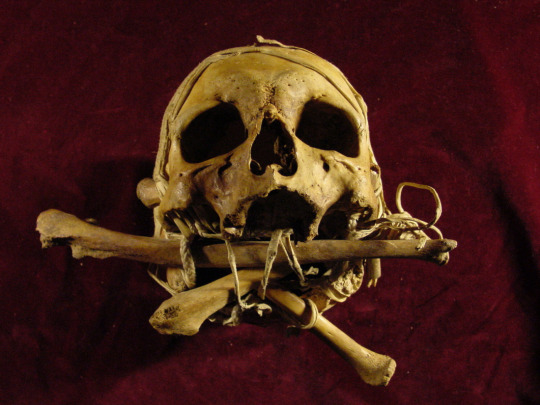
Examples of DeWitt's instruments, courtesy of the artist's website.

A bone flute.


Though there is some sinister-sounding moaning and lamenting to be found within, The Secret Eye of L.A.Y.L.A.H. is a more subtle, reserved affair than you might expect from an album I consistently introduce to friends by howling IT’S MADE OF BOOOOOONNNNESSSS. There is something truly unsettling about the gnarly rattling sounds on “Atavism Dream” even if you don’t know their source, but the track’s chirping wind sounds and peppy hand drumming might conjure imagery of a jungle bird sanctuary or a medicine ceremony. As with a lot of Aleister Crowley-influenced occultism, beneath its transgressive aesthetics L.A.Y.L.A.H. ultimately has a relatively positive, humanist intent. DeWitt isn’t trying to scare the bejeezus out of the listener, but rather to create a soundtrack for deep ritual work and/or fucking, which are indivisible in Thelemic practice. I would imagine spending a few weeks sawing human bones would enforce a degree of solemnity, and the record has the flavour of intense concentration. Creating instruments out of remains can be seen as a mordant spectacle, or an instance of bees making honey in a lion’s skull—in my estimation L.A.Y.L.A.H. has something of both, though DeWitt clearly did not set out to make something cheap.
In the years since its original release The Secret Eye of L.A.Y.L.A.H. has been more talked about than heard despite a handful of reissues, but within dark and ritual ambient circles it has a strong reputation. In 2020 Austrian label Infinite Fog released the Zero Kama box set, which packages together the original LP with a collection of pre- and post-L.A.Y.L.A.H. compilation tracks (The Goatherd and the Beast), a radio interview, and Live in Arnheim, a recording of the second and last Zero Kama performance during the project’s original lifespan. (DeWitt returned to the project in 2022 for a show in New York City.)
youtube
Both additions to the Zero Kama story are of interest. The Goatherd and the Beast finds DeWitt both developing the Zero Kama style and wrestling with its boundaries. On 1983’s “V.V.V.V.V.,” a lengthy dirge and the earliest track to utilize the bone instruments, we can see how quickly DeWitt found her voice with the project (though it is murkier and more lo-fi than similar L.A.Y.L.A.H. tracks like “Death Posture”). That’s a testament to the clarity of her vision, but also to how limiting using the instruments could be; DeWitt herself notes in a retrospective interview included with the set that she never felt she was able to meaningfully expand upon what she’d done with the initial LP. But the 1985–86 tracks nonetheless find her making interesting bargains with a strict muse. DeWitt collaborates with other musicians and incorporates non-bone bass, guitar, and even some cranky vocals. The rhythms are more industrial, and the result hews closer to something like 23 Skidoo’s “urban gamelan” sound. They’re good, but you get the sense DeWitt is moving towards a sound that would be more aptly realized as a new project.

The prize of the set however is the Live in Arnheim performance. Many L.A.Y.L.A.H. listeners are disappointed that it’s not nearly as twisted-sounding as its reputation suggests, but the Arnheim set might win even the skeptical over. Recorded as a four-piece with a pair of percussionists and regular collaborator Muki Pakesch on guitar and tape manipulations, the live iteration of Zero Kama has a chaotic edge and some muscle behind it. DeWitt howls the words of the occult “Quabalistic Cross” and “Prayer of Zos” like a post-punk frontperson, while “Seven Nights of the Tantra” and the battering “Pygmy Dance” work themselves into a visionary lather. “The Call of the Aethyrs” introduces discordant violins over a chorus of lamenting voices, tormented screams, and those ubiquitous skull drums. It’s pretty fucking goth! Live at Arnheim ends with a lengthy synthesized recording of a Latin mass, which the liners note was the soundtrack to “a BDSM performance involving animal blood.”
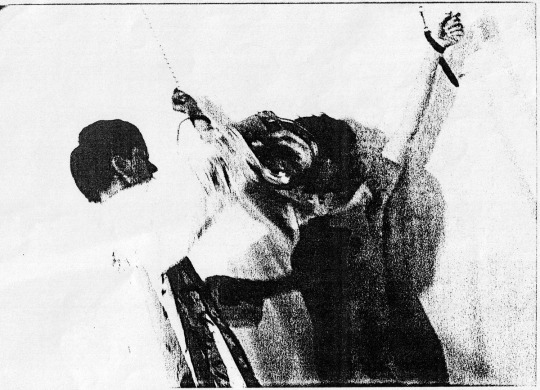

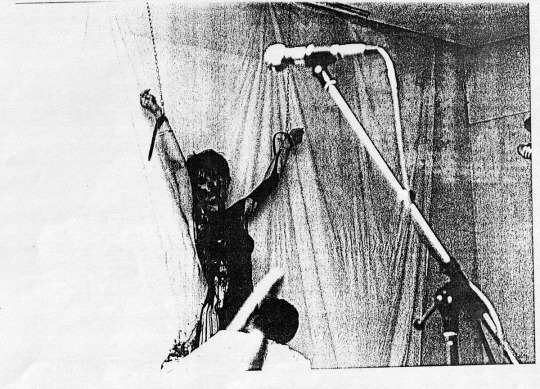
Between the original LP and Arnheim, you end up with two extremes of the whole bone music concept: a meditative, more-or-less respectful private ceremony, and a fright-wigged, blood-soaked exercise in public hedonism. Whether you regard DeWitt’s instruments as gruesome toys or the sacred tools of an occultist, they exert an undeniable fascination. The Zero Kama box satisfies both perspectives, and makes for great listening as we enter the seasons of outer darkness.

199/365
#halloweek#zero kama#zoe dewitt#bone instrument#kangling#aleister crowley#genesis p orridge#psychic tv#throbbing gristle#infinite fog#austrian music#dark ambient#ritual ambient#post punk#industrial#goth music#'80s music#nekrophile records
2 notes
·
View notes
Text
my thoughts when choosing music for studying rn:
regular music - i constantly focus on the words
music in a language i dont understand - i still for some reason focus on the words
music with no words - i focus on the instruments
tibetan flute music - perfection
0 notes
Text
Assessment 4 - Blog s3840808
Week 1:
I found the introductory class to AudioVision very interesting. We had a look at a unique instrument created by Canadian composer Mark Korven, called the Apprehension Machine. It features multiple components; some metal rods, a single string with an attached ebow, metal rulers, etc. From what I’ve read, it was designed for writing horror scores and was actually featured on Robert Eggers’ The Lighthouse and The Witch. I’d be very keen to play and experiment with it in the future. We also had a look at the Japanese concept, ikigai, which translates to ‘ a reason for being’. The ikigai states that your purpose in life should consist of what you love, what you’re good at, what you can be paid for, and what the world needs. Darrin also recommended Sweet Anticipation, a book by David Huron on psychology and music, which I’ll definitely have a read of.
youtube
Week 2:
During the second week I worked on assignment 1 which involved creating sound for an animation of Gina Moore’s. It was fun composing for visuals again - I haven’t done it since 2020 when I was studying sound production. It was interesting seeing everyone’s approach to the assignment. Despite being completely different from one another, I can see why each person went the direction they did. I watched an interesting interview with Hans Zimmer where he discussed the creative process of scoring Dune. He made a good point in saying that it’s odd that almost all sci-fi movies like Star Wars, Alien, 2001: A Space Odyssey, etc. feature european orchestral sounds despite them taking place in other worlds and cultures. Zimmer set out to create a unique sound that mirrored the dark atmosphere that the Dune universe encapsulates. It was also interesting hearing how he described what kind of sounds he was going for, for example, he’d tell his celloist to play the cello like a Tibetan war horn or his flautist to play the flute like it were the wind whistling. It was a fascinating insight into how he operates as a composer and it gave me a lot to think about moving forward as a sound designer/composer.
youtube
Week 3:
During week 3 we had a guest lecturer, Mark Hooper, who has done sound design work on multiple films/tv shows throughout the years. I found his lecture very engaging and gained alot of insight on his thought process when it comes to approaching a new project. A useful piece of information I picked up from Mark was how to effectively fade in and out audio between scenes; Fading audio for scene A out one frame after and fading audio for scene B in one frame before. Mark also emphasized the importance of prioritizing time when working on a project, saying its better to focus more time on impactful moments - themes, motifs, signature sounds, etc. , as opposed to getting caught up on less important details. This is something I often struggle with myself. I find myself obsessing over tiny details and then begin to stress out when deadlines grow closer. This is something I’ll need to work on continuing on in the future. Mark also recommended a book by Walter Murch called In the Blink of an Eye, which focuses on the art of editing in filmmaking. I intend to look into this in the near future. I recently watched Justine Triet’s, Anatomy of a Fall, and really enjoyed it’s approach to sound design. From memory, all sound is diagetic and I assume they went for this approach in order to keep the audience’s attention on the dialouge as it plays the most important role in the film. The sound feels extremely grounded and realistic - you really get an idea of the tone and character of each space in the film, whether that be interior or exterior. There are a few recurring songs that play throughout the film, serving as important plot devices. I wont spoil anything but I enjoyed how they used sound as a pivotal factor in driving the plot forwards.
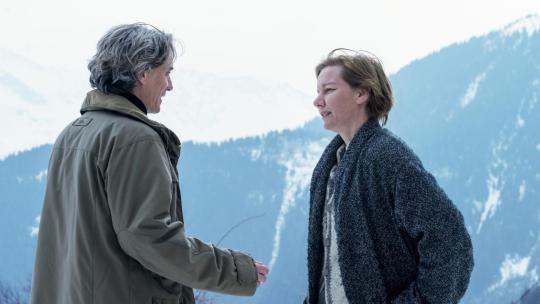
Week 6:
These past two weeks I've begun working on the soundtrack for my collaborative project. The soundtrack will complement a horror game featuring elements of traditional Chinese folklore and Taoism. My collaborator, Yue, wants the music to be eerie, atmospheric and slow burning rather than grandiose or jump scare orientated. In terms of instrumentation, gongs, vocal choir chants, droning synthesisers and bells are being utilised. I recently watched a Japanese film called Kairo, directed by Kiyoshi Kurosawa. I found the film's sound design particularly interesting; dialogue often sounds extremely close in proximity and white noise can be heard in almost every scene creating quite an unnerving atmosphere. Additionally, the soundtrack itself is rather minimal for the most part, often revolving around some droning sounds, which lends itself to the dark atmosphere of the film.

Week 7:
This past week I've made some significant progress in my collaborative project. I created a few different demos of potential soundtracks and sent them to Yue to get an idea of what direction I should be heading for. They were very happy with one demo in particular so I've been working on refining the idea and creating two other pieces with a similar essence. I’ve been reading Karen Collins' Game Sound: An Introduction to the History, Theory, and Practice of Video Game Music and Sound Design and have been picking up a few ideas and tips from it. Collins speaks of the importance of experimenting with different variables to ensure that a composition gets a “longer shelf life”. One of the aforementioned variables includes rhythmic changes - in a major key a sudden rhythmic change can create a sense of positive anticipation, whereas in a minor key it can create a sense of dread or fear. Collins also states that avoiding harmonic resolutions can make a composition more adaptable to gameplay changes, allowing the music to flow in multiple directions. I've also been reading Michael Chion's Audio-vision: Sound on Screen. Chion states that there are two ways in which music and sound can establish a specific emotion: empathetic effect or anempathetic effect. Empathetic sound correlates directly to the emotion being shown on screen, while anempathetic sound is indifferent to what is being shown on screen. The juxtaposition of anempathetic music and on-screen visuals has the effect of intensifying an emotion. I recently watched a Japanese psychological horror film called Cure by Kiyoshi Kurosawa and noticed it utilises the anempathetic effect multiple times during its runtime. For example, during the opening scene quirky jovial music plays as a man murders someone in cold blood. The music being played is emotionally detached to what is being shown on screen and made the scene seem far more disturbing as a result. Perhaps this is a technique I could try to incorporate into my collaborative project.
Week 8:
This week I’ve been developing my collaborative work further. Taoist and Buddhist themes are a key element of the game I’m working on and my collaborator has expressed the importance of including traditional Buddhist instrumentation in the compositions. As such I researched what instruments are involved in Buddhist rituals. As Zhang states, Buddhist instrumentation and music differs depending on region but a few notable instruments include gongs, the Gu drum, di and xao (two different flutes) and chimes. Vocal chanting is also prominent in Buddhist music and is an element I’ve utilised heavily in one of the compositions. I read Tibetan Tantric Buddhism: Envisioning Death by Kathryn Coster to get an idea of the instrumentation used for Buddhist funeral ceremonies, as a major scene I’m composing for in the game is set at a funeral. I discovered that the kangling, a trumpet made from a human thighbone, representing death and impermanence, is commonly used. The kangling produces a haunting sound and fits in well with the themes of the game’s narrative.

Week 9:
I’ve made further progress on my collaborative work this week. Presently, I’ve been focusing purely on the musical composition of the project but I’m beginning to prepare myself for the sound effect aspect. To gain further insight into horror sound design in video games, I’ve been reading Sound and the diegesis in survival-horror games (2008), a paper by Daniel Kromand, and have picked up a lot. Kromand (2008) states that sound design in horror games often create “a framework of uncertainty that constantly holds the player between knowledge and ignorance”. Horror games purposely confuse and mislead players by making it uncertain which sounds are diagetic or not. The inability to locate the source of these sounds causes unease in players. As Kromand (2008) puts it, “collapse of the barrier between the diegetic and non-diegetic soundscape is a strategy to build a horror atmosphere”. Kromand (2008) also brings up an interesting sound design technique used in the game, Bioshock (2007), in which crescendos, which often are used in horror films to create fear and symbolise impending danger, are instead activated by how much time has passed. This preconceived notion of the traditional use of crescendos (in a horror context) causes constant confusion in players and puts them on edge as they begin to anticipate conflict that may not even happen.
I’ve also been reading a paper by Mark Grimshaw called, The audio Uncanny Valley: Sound, fear and the horror game (2009), which goes into the utilisation of the uncanny valley phenomenon in relation to sound design. Grimshaw (2009) states that by defamiliarising an everyday mundane sound through use of different processing techniques, you create an unnerving uncanny valley-like feeling. An example of this can be seen in Ringu (1998), in which the sound of the ringing telephone is actually a combination of four different phone rings at once.
I look forward to putting these different techniques to use for my collaborative work.
Week 10:
This week I did further research into video game-based sound design. I came across a really interesting youtuber called Marshall McGee. His videos often break down specific games, analysing how they've approached the sound design and how they've achieved it. He also interviews industry experts from time to time, which is rather insightful. A recent video of his I watched goes through a trending sound stylisation being frequently used in the industry at the moment. The sound I'm referring to is a low mid-range rumble. The sound is achieved by using an envelope follower which opens up a filter, creating a sense of movement, and by focusing in on 180hz -400hz. The sound is then ran through various modulation effects and multi-band compression. I've also been watching another youtuber, David Dumais, who makes similar videos. He has a video providing tips on creating a sound design demo reel which I've found useful as I'm in the process of creating one at the moment for an internship application.
youtube
Week 11:
This week we all uploaded our works-in-progress to Canvas and gave each other feedback. For Angus' project, I suggested some extra harmonies could slowly be introduced for the sadder song as it progresses to add some extra emotional weight. I also recommended utilising more percussive elements to the happier-sounding song to bring more energy to the composition. I really liked what both Hugh and Ryan were able to accomplish in the Us! animation. I think the score and sound design match the style and tone of the animation perfectly. One thing I suggested though was to cut out the music from 1:36 to 1:48 to enhance the comedic effect of the situation on screen. Also, I think adding a large, spacious reverb to the sound of the character's movements during the outer space scene would work well to reflect the sense of the environment. I was a big fan of Nick's work on the Worm's Memoirs score. The gradual transition from playfulness to horrific was well-executed and I loved the piano tone of the ending rendition of the main theme. One piece of criticism I had though was the tone of the flute; it came across as quite jarring and 'pokey' sounding. I suggested using some subtractive EQ to mend the issue.
I was very pleased with the positive feedback I received from my peers. I feel that I've been successful in accomplishing what I set out to achieve. Regarding criticism and suggestions, Nick feels that the synth tone in one of the songs is too clean sounding and suggested using downsampling or modulation to help it flow with the rest of the instrumentation. Dylan echoed something similar, pointing out that the synth's timbre is quite different from the rest of the organic-sounding instrumentation present in the soundtrack. This is something I'll look into mending. I've already begun playing around with downsampling, saturation, and modulation and it's already sounding a lot more fitting. Erin suggested adding more bass melodies to fill out the sound on some of the tracks which I agree with. Some sections of the songs couldn't definitely use lower-end elements to add more depth to the compositions. Angus liked the whispers present in one of the tracks and would like to hear them come in more often. He also suggested making an alternative version of one of the songs when the camera mode is activated which might be difficult to achieve this close to the deadline, especially considering that camera mode is a key mechanic of the gameplay and reoccurs constantly throughout its entirety. This would mean I'd have to create an alternative version of each of the tracks. I do think it's a cool concept though and it's something I'd like to experiment with in similar projects in the future.
Overall, I'm happy with the feedback and suggestions I received from my peers and found this exercise very useful. I'm really excited to see everyone's final projects!
Final Entry:
I've finished my project for the semester and I'm pleased with the outcome. I was glad to receive feedback from my peers and implemented a few suggestions. I ended up downsampling and saturating the synth's lead line, which both Nick and Dylan said sounded a little out of place, and it definitely made it fit better in the mix. I experimented with using different instrumentation altogether but it didn't feel quite right and my collaborator was already sold on what I had previously delivered and I didn't wanna alter too much as the deadline approached. In response to Erin's suggestion, I implemented bass notes from a piano and boosted around 100hz to add more low end to one of the song arrangements. Although I'm happy with how the soundtrack worked out, there are a few things I'd change and add if I were to do it again with the insight I have now. Firstly, I liked Angus' suggestion to make an alternative version of each track depending on which camera mode is activated. I would have worked on it if I had more time, but unfortunately, I was too close to the deadline to make this a reality. I also would have liked to have worked on more of the SFX for the game. Yue (my collaborator) ended up doing a majority of it as she wanted me to focus more on the music and already had her heart set on a lot of the specific sounds. It's a shame as I had a lot of fun working with more SFX-orientated work for my Sound Design class, where I reworked all of the sound for the opening sequence of the game, Bioshock. Here's a link if you're interested in checking it out. After all the projects I've worked on this semester in both AudioVision and Sound Design, I know that working in sound design is definitely the career I want to pursue moving forward.
Bibliography:
Chion, M. (1994). Audio-vision: Sound on Screen.
Collins, K. (2008). Game Sound: An Introduction to the History, Theory, and Practice of Video Game Music and Sound Design (1st ed.). MIT Press. https://doi.org/10.7551/mitpress/7909.001.0001
Coster, K. (2010). Tibetan Tantric Buddhism: Envisioning Death.
David Dumais Audio. (2020, December 14). How To Make A Video Game Sound Design Demo Reel | 10 Tips [Video]. https://www.youtube.com/watch?v=_VTG6zTyZpg&ab_channel=DavidDumaisAudio
Grimshaw, M. (2009). The audio Uncanny Valley: Sound, fear and the horror game.
Huron, D. (2008). Sweet Anticipation: Music and the Psychology of Expectation.
Kromand, D. (2008). Sound and the diegesis in survival-horror games
Kurosawa, K. (Director). (1997). Cure [Film]. Daiei Film.
Kurosawa, K. (Director). (2001). Kairo [Film]. Daiei Film.
Marshall McGee. (2023, August 2). The “Secret Sauce” In Modern Sound Design [Video].https://www.youtube.com/watch?v=T14Er_xHRRo&t=387s&ab_channel=MarshallMcGee
Murch, W. (2005). In the Blink of an Eye.
Nakata, H. (Director). (1998). Ringu [Film]. Rasen Production Committee.
Triet, J. (Director). (2023). Anatomy of a Fall [Film]. Les Films Pelléas.
Vanity Fair. (2022, March 18). How 'Dune' Composer Hans Zimmer Created the Oscar-Winning Score [Video]. https://www.youtube.com/watch?v=93A1ryc-WW0&t=2s&ab_channel=VanityFair
Zhang, J. (2023). Buddhist Music as a Contested Site: The Transmission of Teochew Buddhist Music between China and Singapore.
2k Games. (2007). Bioshock.
1 note
·
View note
Video
youtube
Tibetan Flute Music | Himalayan Flute Music | Meditation Music | (बाँसुर...
#youtube#TibetanFluteMusic Serenity MusicHeals InnerPeace YouTubeMusic MusicalJourney MysticalMelodies
0 notes
Text
youtube
Remove all negative energy in and around you, release all blockages from mental patterns and beliefs, and find back to a life, as all-embracing as you would like it to be! This specially composed meditation and/or sleep music in the Divine Frequency of 111 Hz, featuring a flute and a Tibetan bowl, embedded in relaxing sounds of nighttime nature, is here for you to lovingly accompany you with positive healing vibrations in your process of spiritual cleansing and emotional detox. If you enjoy my music and would like to support me, you are welcome to donate by tipping on Tumblr! & Please make sure to show your support by subscribing to my Tumblr @fionaxandria1788 where I will be posting vocational shamanic healing posts and meditations from everywhere! :) <33 Much Love and Happy New Year everybody! Happy Full Moon! Check out my Full Moon report as well, I posted it 2hrs ago. Happy New Year everyone! xoxoxo Much Love FionaXandria
#witchlife#shamanic#shaman journey#shamanism#altered consciousness#conscious living#consciousness#self conscious#conscious awareness#eclectic witch#self improvement#self love#self ship#self care#self care thread#self care reminder#daily self care#meditation#fionaxandria1788#fionaxandria#original post#original content#random thoughts#original work#shower thoughts#random#spilled poetry#spilled thoughts#words#spilled writing
0 notes